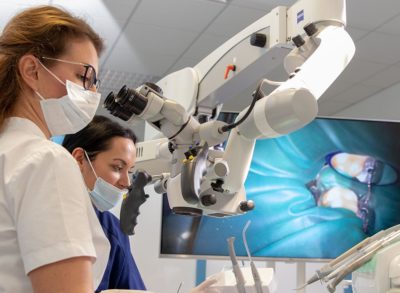In the first place, the endodontics or endodontology deals with the therapy of diseases in the internal tissue within the tooth (tooth pulp); this is named root treatment. The endodontic treatment includes measures for the rescue of the pulp and – if this is not possible anymore – for the restoration of bacteria-free conditions in the root canal and the adjacent tissue close to the apex.

The aim is the maintaining of the tooth as well a sustainable protection of the body against medical conditions that may be caused by diseased teeth. To achieve this goal an intensive and mostly time consuming treatment is needed because the criterion for a sustainable success not only counts the individual freedom from discomfort but also a sterile and bacteria-resistant root filling that reaches to the outlet at the apex and that the root filling paste seals this area. It takes a lot of time, a good sight and the respective knowledge to approach this goal for a lifetime durability. For instance, the time exposure means for the posterior teeth more two than one time for treatment, the utilization of a visual aid (surgery microscope) for a perfect magnification and illumination of the inner tooth and, last not least, the knowledge how and where with a bacteria-free condition in the entire canal system may be achieved. In doing so, the cofferdam is a necessary and genius tool. This is a rubber lug stretched on a frame that has holes in the places of the teeth and will be put over the teeth and fixed by a clamp to the tooth. This lug prevents from the saliva entry and thus a bacterial invasion to the dental canal, protects from the aggressive rinsing that should kill the bacteria within the canal, protects the customer from small tools and, last not least, unburdens the assistant who instead may care for other important tasks.
Years ago the root canal treatment which was considered as complicated and very unpredictable started to provide a good success and through the better results I more and more was enjoying making nice root fillings with a good prognosis. I was deciding to attend a training at the Deutschen Gesellschaft fĂĽr Endodontologie and Zahnärztliche Traumatologie E.V. (German Association for Endontics and Dental Traumatology), which I passed from September 2009 to July 2010. During the course we learned to use the surgical microscope and after a short time I saw, that this device is a sine qua non for better results and so I purchased a such for my dental office. You only may treat what you can see – this wisdom applies very much to the root canal treatment where you, without a visual aid and optical magnification, have to work in the dark. The immense evolvement of knowledge and technical achievements in this field, today, allow such a good prognosis of 95 % for five years of teeth with a treated root canal as well as for implants. In my estimation the success rate is higher. Even teeth with a large foci may be maintained and the inflammation of the apex recedes if it is not a real cyst. Today, real cysts, entirely constricted root canals and endodontic posts are the absolute indication for a root tip resection. A tooth root resected without healing success may be successfully treated with the microscopic technique. Nowadays, in my office with this modern treatment only about five root tip resections and more than one hundred root treatments are performed a year.
In general, a root canal treatment takes maximum two sessions an only if an acute inflammatory process in the bone around the root tip impedes the completion. Usually, with a prior planning all root canal treatments will be completed within one session.
For your benefit, your
Zsolt Fischer

